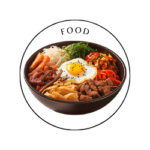 Mind
Mind
- Digital and Modern Well-being
- Mental Health and Emotional Well-being
- Mind-Body Connection and Holistic Health
- Parenting and Family
- Personal Growth and Development
- Relationships and Social Well-being
- Stress and Relaxation
- Therapeutic and Creative Practices
- Trauma and Recovery
- Work, Productivity, and Discipline
 Body
Body
 Fitness
Fitness
 Food
Food
 Beauty
Beauty
Gluten-Free Diet

Gluten-Free Diet: What You Can and Can’t Eat
The gluten-free diet has become essential for many people, whether due to a medical condition like coeliac disease or non-coeliac gluten sensitivity, or as a lifestyle choice. With gluten found in many everyday products, navigating this diet can be daunting at first, but with the right knowledge, it becomes much easier.
In this blog post, we’ll explore what gluten is, why people avoid it, and break down the foods you can and can’t eat on a gluten-free diet, with tips for maintaining variety and nutrition in your meals.
What is Gluten?
Gluten is a type of protein found in certain grains, including wheat, barley, and rye. Its elastic properties help dough rise and maintain its shape, giving bread and other baked goods their chewy texture.
However, for some people, consuming gluten triggers harmful health effects. In people with coeliac disease, gluten triggers an autoimmune response that damages the small intestine, leading to digestive issues, nutrient deficiencies, and other serious health problems. Those with non-coeliac gluten sensitivity experience symptoms like bloating, diarrhoea, and fatigue, though without intestinal damage.
What You Can Eat on a Gluten-Free Diet
Naturally Gluten-Free Foods
The good news is that many whole, unprocessed foods are naturally gluten-free, offering plenty of variety and nutrition.
- Fruits and Vegetables: Fresh, frozen, or dried fruits and vegetables are naturally gluten-free and should form the basis of any healthy diet.
- Meat and Fish: Plain, unprocessed meat, poultry, fish, and seafood are gluten-free. Be cautious with breaded or marinated products, which may contain gluten.
- Eggs: A versatile and naturally gluten-free protein source.
- Dairy: Milk, cheese, butter, and plain yogurt are gluten-free. Be cautious of flavoured or processed dairy products, as they may contain additives or thickeners with gluten.
- Legumes and Beans: Lentils, chickpeas, black beans, and other legumes are gluten-free and rich in fibre and protein.
- Nuts and Seeds: All nuts and seeds are naturally gluten-free, but check for any added flavourings or coatings that could contain gluten.
Gluten-Free Grains and Starches
While wheat and other gluten-containing grains are off-limits, there are many naturally gluten-free alternatives:
- Rice: White, brown, wild, and other types of rice are gluten-free.
- Quinoa: A protein-packed grain that’s naturally gluten-free.
- Corn: Cornmeal, polenta, and plain popcorn are gluten-free options.
- Potatoes: Both white and sweet potatoes are naturally gluten-free and highly versatile.
- Gluten-Free Oats: While oats themselves do not contain gluten, cross-contamination is common. Look for oats labelled as gluten-free to ensure safety.
- Buckwheat: Despite its name, buckwheat is gluten-free and a nutritious option for baking and cooking.
- Tapioca, Arrowroot, and Sorghum: These starches and grains are gluten-free and useful in gluten-free baking.
Gluten-Free Packaged Foods
The availability of gluten-free products has grown rapidly in recent years, making it easier to follow this diet. Many grocery stores now stock a range of:
- Gluten-Free Bread and Pasta: Made from gluten-free grains like rice, quinoa, and corn.
- Gluten-Free Crackers and Snacks: Many brands offer gluten-free crackers, rice cakes, and snack bars.
- Gluten-Free Baking Mixes: Look for all-purpose gluten-free flour blends for baking at home.
What You Can’t Eat on a Gluten-Free Diet
Gluten-Containing Grains and Foods
The key to a gluten-free diet is avoiding all foods that contain gluten, including:
- Wheat: This includes all varieties of wheat such as durum, semolina, spelt, and farro. Wheat is found in bread, pasta, pastries, crackers, and many processed foods.
- Barley: Commonly used in malt, beer, soups, and food additives.
- Rye: Typically found in rye bread and rye-based cereals.
- Triticale: A hybrid grain that is a cross between wheat and rye.
Hidden Sources of Gluten
Gluten often hides in unexpected places, particularly in processed and packaged foods. Common sources include:
- Sauces and Condiments: Soy sauce, malt vinegar, and some salad dressings and gravies may contain gluten.
- Processed Meats: Some deli meats, sausages, and meat substitutes contain gluten.
- Seasoned Snacks: Be wary of flavoured crisps, chips, and crackers.
- Baked Goods and Pastries: Even gluten-free options may be at risk of cross-contamination during production.
- Beer and Malt Beverages: Regular beer is made from barley and is off-limits. However, there are gluten-free beers available.
Cross-Contamination Risk
Even small amounts of gluten can cause a reaction in people with coeliac disease. Cross-contamination happens when gluten-free foods come into contact with gluten-containing products. To avoid this:
- Use separate kitchen tools such as toasters, cutting boards, and utensils for gluten-free cooking.
- Check labels on all processed foods for hidden sources of gluten or cross-contamination warnings.
Tips for Maintaining a Balanced Gluten-Free Diet
It’s essential to focus on a balanced diet rich in vitamins and minerals, especially since avoiding gluten-containing grains can sometimes lead to nutrient deficiencies. Here are some tips:
- Variety is Key: Incorporate a wide range of naturally gluten-free fruits, vegetables, and proteins to ensure you’re getting all the nutrients you need.
- Be Mindful of Fibre: Many gluten-containing products are rich in fibre, so it’s important to include fibre-rich foods like beans, lentils, and gluten-free whole grains.
- Watch for Additives: Many processed gluten-free products can be high in sugar and low in nutrients, so always check the ingredient list.
- Stay Informed: The gluten-free landscape is constantly changing with new products and research. Staying updated on the latest gluten-free brands and developments can help you make better choices.
Final Thoughts
Following a gluten-free diet may require extra attention and planning, but it doesn’t mean sacrificing variety or taste. With a bit of creativity and awareness, you can enjoy a wide range of delicious and nutritious foods while avoiding gluten. Whether you’re newly diagnosed or have been gluten-free for years, embracing fresh, whole ingredients and staying informed can help you thrive on this diet.
Enjoy experimenting with gluten-free recipes, and always double-check labels to keep your meals safe and satisfying!
